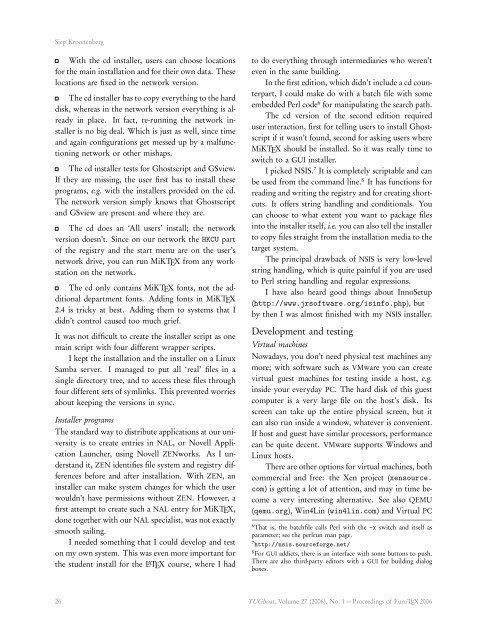The Communications of the TEX Users Group Volume 27 ... - TUG
The Communications of the TEX Users Group Volume 27 ... - TUG
The Communications of the TEX Users Group Volume 27 ... - TUG
Create successful ePaper yourself
Turn your PDF publications into a flip-book with our unique Google optimized e-Paper software.
Siep Kroonenberg<br />
With <strong>the</strong> cd installer, users can choose locations<br />
for <strong>the</strong> main installation and for <strong>the</strong>ir own data. <strong>The</strong>se<br />
locations are fixed in <strong>the</strong> network version.<br />
<strong>The</strong> cd installer has to copy everything to <strong>the</strong> hard<br />
disk, whereas in <strong>the</strong> network version everything is already<br />
in place. In fact, re-running <strong>the</strong> network installer<br />
is no big deal. Which is just as well, since time<br />
and again configurations get messed up by a malfunctioning<br />
network or o<strong>the</strong>r mishaps.<br />
<strong>The</strong> cd installer tests for Ghostscript and GSview.<br />
If <strong>the</strong>y are missing, <strong>the</strong> user first has to install <strong>the</strong>se<br />
programs, e.g. with <strong>the</strong> installers provided on <strong>the</strong> cd.<br />
<strong>The</strong> network version simply knows that Ghostscript<br />
and GSview are present and where <strong>the</strong>y are.<br />
<strong>The</strong> cd does an ‘All users’ install; <strong>the</strong> network<br />
version doesn’t. Since on our network <strong>the</strong> HKCU part<br />
<strong>of</strong> <strong>the</strong> registry and <strong>the</strong> start menu are on <strong>the</strong> user’s<br />
network drive, you can run MiK<strong>TEX</strong> from any workstation<br />
on <strong>the</strong> network.<br />
<strong>The</strong> cd only contains MiK<strong>TEX</strong> fonts, not <strong>the</strong> additional<br />
department fonts. Adding fonts in MiK<strong>TEX</strong><br />
2.4 is tricky at best. Adding <strong>the</strong>m to systems that I<br />
didn’t control caused too much grief.<br />
It was not difficult to create <strong>the</strong> installer script as one<br />
main script with four different wrapper scripts.<br />
I kept <strong>the</strong> installation and <strong>the</strong> installer on a Linux<br />
Samba server. I managed to put all ‘real’ files in a<br />
single directory tree, and to access <strong>the</strong>se files through<br />
four different sets <strong>of</strong> symlinks. This prevented worries<br />
about keeping <strong>the</strong> versions in sync.<br />
Installer programs<br />
<strong>The</strong> standard way to distribute applications at our university<br />
is to create entries in NAL, or Novell Application<br />
Launcher, using Novell ZENworks. As I understand<br />
it, ZEN identifies file system and registry differences<br />
before and after installation. With ZEN, an<br />
installer can make system changes for which <strong>the</strong> user<br />
wouldn’t have permissions without ZEN. However, a<br />
first attempt to create such a NAL entry for MiK<strong>TEX</strong>,<br />
done toge<strong>the</strong>r with our NAL specialist, was not exactly<br />
smooth sailing.<br />
I needed something that I could develop and test<br />
on my own system. This was even more important for<br />
<strong>the</strong> student install for <strong>the</strong> L A<strong>TEX</strong> course, where I had<br />
to do everything through intermediaries who weren’t<br />
even in <strong>the</strong> same building.<br />
In <strong>the</strong> first edition, which didn’t include a cd counterpart,<br />
I could make do with a batch file with some<br />
embedded Perl code 6 for manipulating <strong>the</strong> search path.<br />
<strong>The</strong> cd version <strong>of</strong> <strong>the</strong> second edition required<br />
user interaction, first for telling users to install Ghostscript<br />
if it wasn’t found, second for asking users where<br />
MiK<strong>TEX</strong> should be installed. So it was really time to<br />
switch to a GUI installer.<br />
I picked NSIS. 7 It is completely scriptable and can<br />
be used from <strong>the</strong> command line. 8 It has functions for<br />
reading and writing <strong>the</strong> registry and for creating shortcuts.<br />
It <strong>of</strong>fers string handling and conditionals. You<br />
can choose to what extent you want to package files<br />
into <strong>the</strong> installer itself, i.e. you can also tell <strong>the</strong> installer<br />
to copy files straight from <strong>the</strong> installation media to <strong>the</strong><br />
target system.<br />
<strong>The</strong> principal drawback <strong>of</strong> NSIS is very low-level<br />
string handling, which is quite painful if you are used<br />
to Perl string handling and regular expressions.<br />
I have also heard good things about InnoSetup<br />
(http://www.jrs<strong>of</strong>tware.org/isinfo.php), but<br />
by <strong>the</strong>n I was almost finished with my NSIS installer.<br />
Development and testing<br />
Virtual machines<br />
Nowadays, you don’t need physical test machines any<br />
more; with s<strong>of</strong>tware such as VMware you can create<br />
virtual guest machines for testing inside a host, e.g.<br />
inside your everyday PC. <strong>The</strong> hard disk <strong>of</strong> this guest<br />
computer is a very large file on <strong>the</strong> host’s disk. Its<br />
screen can take up <strong>the</strong> entire physical screen, but it<br />
can also run inside a window, whatever is convenient.<br />
If host and guest have similar processors, performance<br />
can be quite decent. VMware supports Windows and<br />
Linux hosts.<br />
<strong>The</strong>re are o<strong>the</strong>r options for virtual machines, both<br />
commercial and free: <strong>the</strong> Xen project (xensource.<br />
com) is getting a lot <strong>of</strong> attention, and may in time become<br />
a very interesting alternative. See also QEMU<br />
(qemu.org), Win4Lin (win4lin.com) and Virtual PC<br />
6 That is, <strong>the</strong> batchfile calls Perl with <strong>the</strong> -x switch and itself as<br />
parameter; see <strong>the</strong> perlrun man page.<br />
7 http://nsis.sourceforge.net/<br />
8 For GUI addicts, <strong>the</strong>re is an interface with some buttons to push.<br />
<strong>The</strong>re are also third-party editors with a GUI for building dialog<br />
boxes.<br />
26 <strong>TUG</strong>boat, <strong>Volume</strong> <strong>27</strong> (2006), No. 1 — Proceedings <strong>of</strong> Euro<strong>TEX</strong> 2006

















